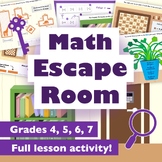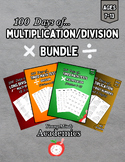146 results
Middle school algebra 2 resources for SMART Notebook
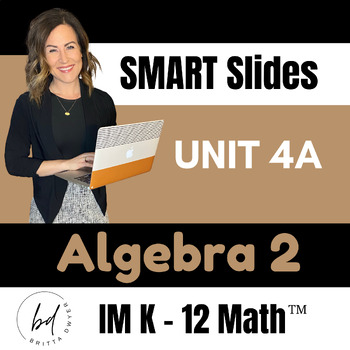
Unit 4A SMART Slides (Lessons 1 - 7) | Algebra 2 | IM K-12 MathTM
This product is based on the IM K-12 MathTM by Illustrative Mathematics® and offered under a CC BY 4.0 License. I created these slides using the slides based on IM K - 12 Math(TM) in conjunction with the teacher notes/guidelines. The slides provided by IM are very simple and left me wanting more for my classroom, so I created more!Lessons Included: Unit 4 Lessons 1 - 7Slides include:Each lesson activity Activity Synthesis Questions (sometimes modified and not identical to teach resources)Lesson
Subjects:
Grades:
6th - 12th
Types:
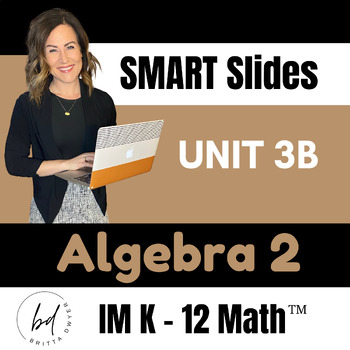
Unit 3B SMART Slides (Lessons 10 - 19) | Algebra 2 | IM K-12 MathTM
This product is based on the IM K-12 MathTM by Illustrative Mathematics® and offered under a CC BY 4.0 License. I created these slides using the slides based on IM K - 12 Math(TM) in conjunction with the teacher notes/guidelines. The slides provided by IM are very simple and left me wanting more for my classroom, so I created more!Lessons Included: Unit 3 Lessons 10 - 19Slides include:Each lesson activity Activity Synthesis Questions (sometimes modified and not identical to teach resources)Lesso
Subjects:
Grades:
6th - 12th
Types:

Unit 3A SMART Slides (Lessons 1 - 9) | Algebra 2 | IM K-12 MathTM
This product is based on the IM K-12 MathTM by Illustrative Mathematics® and offered under a CC BY 4.0 License. I created these slides using the slides based on IM K - 12 Math(TM) in conjunction with the teacher notes/guidelines. The slides provided by IM are very simple and left me wanting more for my classroom, so I created more!Lessons Included: Unit 3 Lessons 1 - 9Slides include:Each lesson activity Activity Synthesis Questions (sometimes modified and not identical to teach resources)Lesson
Subjects:
Grades:
6th - 12th
Types:

Unit 2B SMART Slides | Algebra 2 | Algebra 2 | IM K-12 MathTM
This product is based on the IM K-12 MathTM by Illustrative Mathematics® and offered under a CC BY 4.0 License. I created these slides using the slides based on IM K - 12 Math(TM) in conjunction with the teacher notes/guidelines. The slides provided by IM are very simple and left me wanting more for my classroom, so I created more!Lessons Included: 16 - 26Slides include:Each lesson activity Activity Synthesis Questions (sometimes modified and not identical to teach resources)Lesson SynthesisVari
Subjects:
Grades:
6th - 12th
Types:
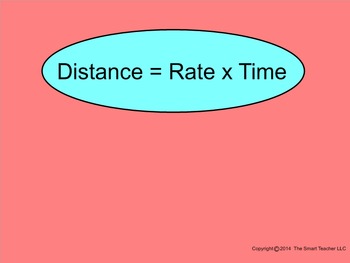
How I Teach Distance Rate and Time Word Problems
This is a 65 page Smartboard lesson covering distance equals rate times time word problems. The lesson covers same direction, round trip, and opposite direction types. Each time is broken down into simple explanation. There is plenty of practice and all practice problems contain answers for immediate feedback.
Subjects:
Grades:
8th - 11th
Types:
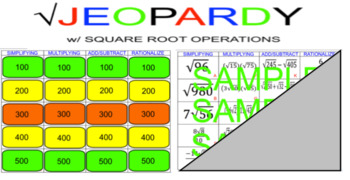
Square Root Operations (Radical) Jeopardy
Students will work in small groups or individually to play this Jeopardy game. Operations include: Simplifying, Multiplying, Adding, Subtracting, Distributing, FOILing, and Rationalizing. This game is provided as Smart Board Activity, but is also offered as a PowerPoint.
Subjects:
Grades:
7th - 12th

How I Teach Functions (Finding a Function Rule)
This is a 32 page Smartboard file covering how to determine a function rule. The lesson starts with a definition for a function rule. Next it is shown that function rules can be found in a table and also in a function machine. The lesson shows how to first expect the function rule to be basic and if that doesn't pan out then go to the more complicated type. There is plenty of practice looking at a table and trying to determine a function rule. All practice pages include answers.
Grades:
8th - 11th
Types:
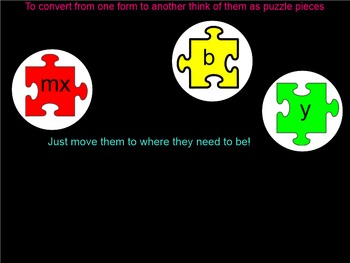
How I Teach Converting From Standard-Form to Slope-Intercept Form
This is a 41 page lesson on how to convert an equation that is in Standard-Form over to Slope-Intercept form. The step by step details should help them to understand. There are plenty of practice problems along with answers.
Grades:
7th - 10th, Higher Education
Types:
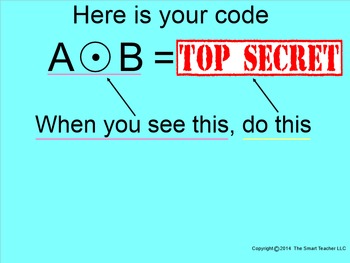
How I Teach Non-Standard Operations Part 1
This is a 54 page Smartboard lesson teaching Non-Standard Operations. Non-Standard Operations are pretty much any math operation outside of your normal add, subtract, multiply, ... This is a skill that is common on the ACT test. The format I chose was to give it a "spy" theme. Your students will be excited to try and break the code! The students learn the code and use it to find the answers. The magnifying glass will help to reveal them.
Grades:
8th - 11th
Types:
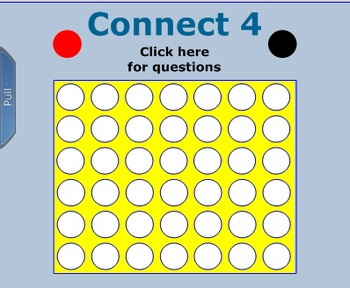
Connect 4 Game Simplifying Monomials Review
This game consists of up to 30 questions for a friendly classroom game of connect 4. This game is easily adapted to other topics as well. (You can easily change this to simplifying monomials and polynomials!)
I divide the class into two teams. I display the board. Then ask a person from the red team to pick a number. Once picked, everyone must answer the question during an allotted time amount. Comparing answers is allowed as long as it's not copying...but explaining!
Next, I randomly pick a p
Subjects:
Grades:
8th - 10th
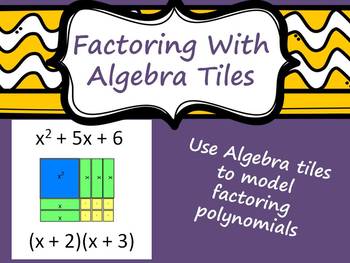
Factoring With Algebra Tiles
This SMART Notebook file leads through two Algebra lessons on factoring polynoials with Algebra tiles. The first lesson uses tiles to factor out a monomial from a polynomial (also called factoring out a GCF or Greatest Common Factor). The second lesson uses tiles to factor quadratic trinomials. Notes are provided on how I use them in my classroom.
Subjects:
Grades:
7th - 10th

How I Teach Simplifying Cube Roots
This is a 30 page lesson file teaching how to simplify cube roots. The lesson explains the process by using prime numbers and a factor tree. There are plenty of practice pages with answers.
Grades:
7th - 10th
Types:
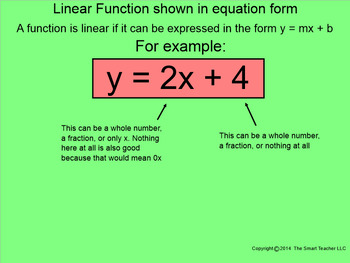
How I Teach Linear and Nonlinear Functions
This is a 33 page Smartboard lesson explaining how to identify functions as linear and nonlinear. Students see 3 different types of functions. Functions as equations, functions graphically, and functions in a table. All have various types and styles and all examples have answers.
Subjects:
Grades:
7th - 10th
Types:
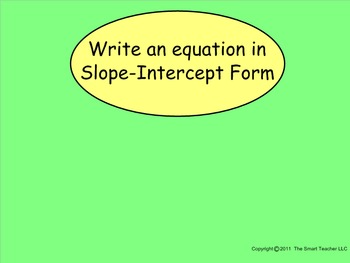
How I Teach Slope Part 5
This is a 39 page Smartboard file teaching how to write an equation in slope-intercept form. The lesson explains how you have a slope part and a y intercept part. The lesson also explains when you are either missing the y intercept or have a slope of zero. There are graphs where two points are given and graphs where the student has to place the points. All practice pages include answers.
Grades:
7th - 10th
Types:

How I Teach Rational and Irrational Numbers
This is a 35 page Smartboard file on the difference between rational and irrational numbers. The lesson starts by describing what it takes to be one type or another. From there the students classify them and tell why. Next the students have to decide which two integers a root would be located between. The lesson finishes by having students try and locate the numbers on a number line. You will find plenty of examples that include answers.
Grades:
7th - 10th
Types:
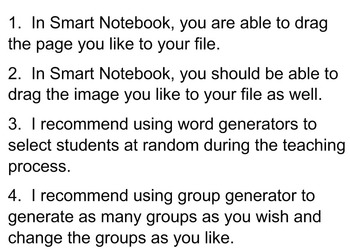
FREEBIE - Templates: Group Generator, Name Chooser, Timer, Activity, ... etc.
This Smart Notebook file contains tools that are helpful to use in managing the classroom. A "Group Generator" tool allows you to generate as many groups as you wish. A "Word Chooser" tool allows you to pick on a student for an answer at random. A "Timer" allows to manage your class time effectively. Different type of timers are also included such as firecracker. Also, for those who are teaching probability, an interactive die, spinner, and card are also available in this template file.
Si
Subjects:
Grades:
PreK - 12th, Higher Education, Adult Education, Staff
Types:
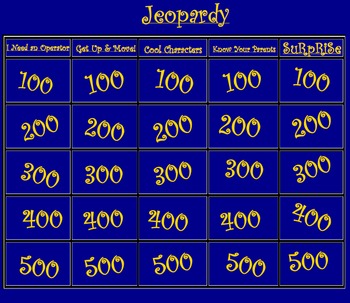
Functions Jeopardy! Lots of Fun for Algebra or even Pre-Calculus
This file contains a functions Jeopardy game that assesses the following skills:
- function operations (including composition)
- evaluating functions
- parent functions & transformations of them (for the questions involving a magnet in the Get Up & Move category, you should actually place a magnet on a coordinate grid on your board - magnet can be any shape, as long as it is noticeable when reflected certain directions)
- characteristics of function graphs
*Please note that this require
Subjects:
Grades:
7th - 12th, Higher Education, Adult Education, Staff
Types:

SmartBoard Lesson on Graphing Linear Inequalities
This is an Algebra lesson for the SmartBoard on graphing linear inequalities and systems of linear inequalities. This Notebook file starts with reviewing the inequality symbols and how to graph an inequality on the number line. It then moves on to the definition of a linear inequality and how to graph one on the coordinate plane. The steps to follow are clearly identified and several example problems are provided. The second half of this lesson gives problems about solving systems of linear ineq
Subjects:
Grades:
8th - 12th, Higher Education, Adult Education

Introduction to Quadratics!- with Application
I don't typically begin teaching a new concept with an application, but this problem offers so many layers that it works really well.
Students split up into groups or pairs and determine the area of various rectangular houses based on a set perimeter and a given width. Already this requires some strategy and problem solving.
Then as a class, they collect and organize their data in a graph and a table. You can then use the graph to introduce new vocabulary (parabola, vertex, axis of symmetry,
Grades:
8th - 11th

Linear Equations Detailed Review Packet
8 page packet providing detailed instructions, examples, and practice problems for the following concepts:
-Finding the slope of a line
-Finding the equation of a line in slope intercept form
-Finding x- and y-intercepts
-Finding the equation of a line given two points
-Finding the equation in point-slope form
-Equations of parallel and perpendicular lines
-How to graph (slope-intercept, point-slope, and x- and y-intercepts)
-Converting an equation into slope intercept form from any other form
Subjects:
Grades:
5th - 10th
Types:
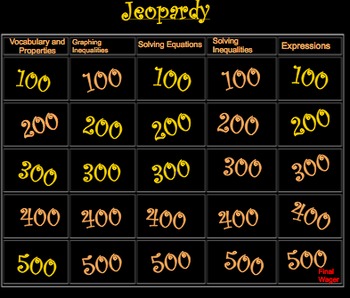
Algebra Equations and Inequalities SmartBoard Jeopardy
When concluding a unit I like to partake in a little competitive practice. I developed this game for my Algebra Equations and Inequalities unit for use on the Smart Board. Problem levels are tiered and get harder as the game progresses. A final wager question is also included in the game.
Grades:
7th - 10th
Types:
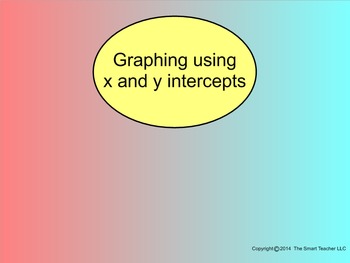
How I Teach Graphing Using X and Y Intercepts
This is a 31 page Smartboard file over how to graph linear equations using x and y intercepts. The lesson explains what it means to be in standard form. Next the lesson has the students fill out an x-y table and plot the points. The last examples are when the intercepts are not whole numbers. There are plenty of practice pages with answers included.
Subjects:
Grades:
7th - 10th
Types:
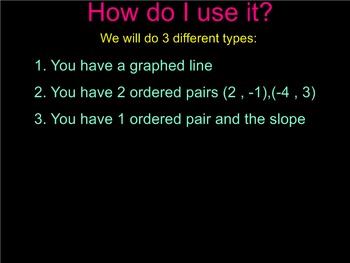
How I Teach Point-Slope Form
This is a 61 page Smartboard file covering how to write equations in point-slope form. There are 3 different styles used. One is when you know one point and the slope. Another is when you know 2 points. The 3rd one is when you have a line plotted on the coordinate plane. All three types have plenty of practice problems that include answers.
Subjects:
Grades:
8th - 11th, Higher Education
Types:

How I Teach Simplifying Radicals Part 1
This is a 55 page Smartboard file on how to simplify radicals. The lesson explains first how to simply something basic like the square root of 20. From there it leads to multiplying square roots and then wraps up with an explanation of how to rationalize the denominator.
Grades:
8th - 11th
Types:
Showing 1-24 of 146 results



